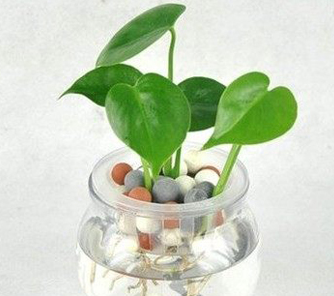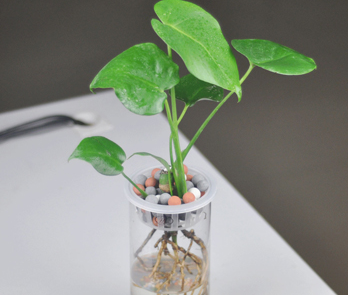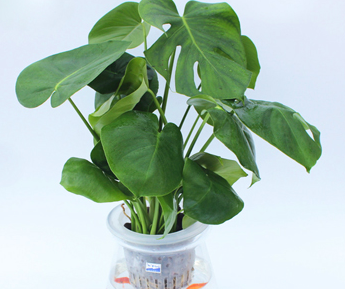Can hydroponic turtles with bamboo on their backs raise fish? can they be cultivated in soil?
If you want to talk about this tortoise-backed bamboo, it is relatively easy to raise, or it can be hydroponically cultivated. Let's take a look at whether hydroponic turtle-backed bamboo can raise fish. Can hydroponic turtle-backed bamboo be cultivated in soil:

Can hydroponic turtles carry bamboo to raise fish:
Generally speaking, hydroponic turtles and bamboo can also raise fish. Only by grasping the principle of "cultivating flowers mainly, fish as a supplement, and small fish as the best" can flowers and fish live in harmony.
Fish farming is a challenge in itself, especially in hydroponic turtles carrying bamboo. Fish culture should not be fed, because fish food is usually organic matter, which will cause deterioration of water quality and bring bacterial damage to plant root growth. On the other hand, hydroponic plant nutrient solution should not be overdosed, otherwise it will lead to the death of fish. In addition, the time interval of changing water should not be too long, which can not only supply oxygen to fish and turtle back bamboo, but also reduce the acid-base gap of water before and after each change of water.
Can hydroponic turtle-backed bamboo be cultivated in soil:
1. Clean the root system.
Rinse the roots of Phyllostachys pubescens with clean water, cut off the rotten roots, and soak them with potassium permanganate diluent.
2. Prepare the flowerpot.
You can choose pottery pots, purple sand pots, plastic pots, or porcelain pots, but the permeability is slightly poor, and the size of the flowerpot generally depends on the size of the plant.
3. Configure potted soil.
The cultivated soil must be loose and breathable, well drained and have a certain ability to retain water and fertilizer. The soil made of peat soil and a small amount of perlite is very suitable. If you are not sure, you can also buy it from the flower market.
4. put it back on the basin.
Straighten the plant in one hand, fill the basin with a shovel in the other, gently lift the plant in the middle of the filling, let the root system stretch naturally, and fill it to 80% full.
5. Late maintenance.
Put the tortoise back bamboo in the semi-shade or scattered light, first spray water on the plant with a spray can, and then pour water into the basin soil. Do not apply fertilizer before taking root. If it is properly maintained, it will grow new roots after a month.
Hydroponic turtle back bamboo can raise fish, and after hydroponic turtle back bamboo can be cultivated in soil, it is more suitable to change hydroponic culture into soil culture in winter.
Can hydroponic turtle back bamboo grow fish? can hydroponic turtle back bamboo be cultivated in soil?
Hydroponic turtle back bamboo is very environmentally friendly, fresh and has a high ornamental value. It is quite tropical in the indoor living room, bedroom and study. A lot of flowers are friendly and strange. Can turtles carry bamboo to raise fish? Can hydroponic turtle back bamboo be cultivated in soil? Let's take a look at the details below.
Can hydroponic turtles carry bamboo to raise fish:
Generally speaking, hydroponic turtles and bamboo can also raise fish. Only by grasping the principle of "cultivating flowers mainly, fish as a supplement, and small fish as the best" can flowers and fish live in harmony.
Fish farming is a challenge in itself, especially in hydroponic turtles carrying bamboo. Fish culture should not be fed, because fish food is usually organic matter, which will cause deterioration of water quality and bring bacterial damage to plant root growth. On the other hand, hydroponic plant nutrient solution should not be overdosed, otherwise it will lead to the death of fish. In addition, the time interval of changing water should not be too long, which can not only supply oxygen to fish and turtle back bamboo, but also reduce the acid-base gap of water before and after each change of water.
Can hydroponic turtle-backed bamboo be cultivated in soil:
Sure.
1. Clean the root system.
Rinse the roots of Phyllostachys pubescens with clean water, cut off the rotten roots, and soak them with potassium permanganate diluent.
2. Prepare the flowerpot.
You can choose pottery pots, purple sand pots, plastic pots, or porcelain pots, but the permeability is slightly poor, and the size of the flowerpot generally depends on the size of the plant.
3. Configure potted soil.
The cultivated soil must be loose and breathable, well drained and have a certain ability to retain water and fertilizer. The soil made of peat soil and a small amount of perlite is very suitable. If you are not sure, you can also buy it from the flower market.
4. put it back on the basin.
Straighten the plant in one hand, fill the basin with a shovel in the other, gently lift the plant in the middle of the filling, let the root system stretch naturally, and fill it to 80% full.
5. Late maintenance.
Put the tortoise back bamboo in the semi-shade or scattered light, first spray water on the plant with a spray can, and then pour water into the basin soil. Do not apply fertilizer before taking root. If it is properly maintained, it will grow new roots after a month.
Can the tortoise back bamboo be hydroponically cultivated after it is truncated?
The tortoise back bamboo itself is propagated by cuttings, so the broken stem is completely suitable for hydroponics. However, because the broken stem may suffer other damage and does not have a root system, it must wait for it to grow new roots in order to better absorb water and nutrients, so it is easy to be infected by bacteria and rot in the process of hydroponic culture. so you might as well use potassium permanganate diluent to kill the virus slightly before hydroponic culture. Hydroponics should also make shading facilities to ensure a certain amount of light, but avoid direct sunlight, and it is also necessary to spray water to the leaves. Wait for it to grow roots to really survive, at this time can return to normal watering, fertilization and other nursing measures.
What are the hydroponic plants? how to grow hydroponic plants?
Hydroponic plant culture is a common method of plant culture in modern homes, which is different from the traditional method of raising plants in the soil, but breeding plants in water and adding the nutrient solution needed by plants. Hydroponic plants have better ornamental, now there are several goldfish in hydroponic plants, which have better decorative effect, so what are hydroponic plants? The following will introduce you one by one.
[what are the hydroponic plants?]
The plants that can be hydroponically cultured are tortoise-backed bamboo, Milan, gentleman orchid, camellia, rose, jasmine, rhododendron, evergreen, violet, Phalaenopsis, inverted golden bell, five-needle pine, rubber banyan, Brazilian iron, begonia, ferns, palms, etc., as well as various foliage plants, such as tufted taro, silver-bract taro, fire crane flower, Guangdong hanging orchid, Yinbian evergreen.
There are more than a hundred kinds of lotus palm, hibiscus palm and other kinds of orchid, Paphiopedilum, crab claw orchid, rich bamboo, pineapple, silver leaf chrysanthemum, Brazilian wood, ivy, colored leaf grass and so on. Basically, plants that can be planted in the soil can be hydroponically cultivated, but a small number of plants that prefer a dry environment are not suitable for hydroponics.
In addition, plants need sunlight, so when cultivating indoor hydroponic plants, we should pay attention to choosing the growth environment of hydroponic plants according to different plant species.
[how to grow hydroponic plants]
1. Attach importance to the stage
From the perspective of plant growth cycle, hydroponic flower culture technology has two technical stages that need to be paid attention to: one is the cultivation stage of seedlings, that is, the hydroponic propagation process, and the other is the nursing stage of plant finished products. that is, the hydroponic culture process of individual operation after the success of hydroponic culture. Through the maintenance of these two stages, following the correct rules of hydroponics, and paying attention to the problems that need to be paid attention to in the process of breeding, we can see beautiful and elegant, clean and healthy hydroponic flowers.
2. Soilless domestication
(1) planting of large seedlings: tap around the flowerpot with your hand and remove the whole plant from the pot after the soil is loosened. Gently remove the soil by hand, or rinse directly with water; then cut the planting basket. If the head of the plant is too large and the aperture of the planting basket is too small, the hole of the planting basket needs to be enlarged to facilitate planting. After that, add the nutrient solution to the container, insert the roots of the large seedlings from the planting basket, and then fix them with sponges or stones to avoid root damage.
(2) small seedling planting: small seedling planting is much simpler than large seedling planting. Generally, the seedlings taken are no more than 8 centimeters, and the seedlings are taken out directly from the basin, and the roots can be washed a little in the water, paying attention not to accidentally hurt the roots; then begin to plant the seedlings and insert the roots directly from the holes in the planting basket. just fix it with a stone.
(3) the blending of nutrient solution: with regard to the blending of hydroponic flower nutrient solution, it can be purchased and prepared at the chemical reagent store according to the formula provided by the relevant data, and urea and other fertilizers can also be used in hydroponic flowers according to the local fertilizer source. after gaining experience, the total concentration of other fertilizers should be controlled at 0. 1% Murray 0. 2%.
(4) the main points of transplanting flowers: the water level of hydroponic flowers must be controlled, which should be low rather than high. Keep plant roots in water, or even less, for a month of adaptation, and then gradually increase the amount of water later. In the process of hydroponic culture, when water droplets appear at the leaf tip of flowers, the water level of hydroponic culture should be reduced appropriately, and attention should be paid to avoid direct sunlight when hydroponic culture is just carried out.
3. Soilless trough planting
(1) the establishment and method of hydroponic nursery bed: the hydroponic seedling bed should not leak, and it is usually made of concrete or brick with a width of about 1. 2Murray 1. 5 meters, the length depends on the scale, it is best to build a stepped seedbed, which is conducive to the flow of water and maintain the oxygen content in the water. An electric hot line for heating the water supply is laid at the bottom of the bed to stabilize the water temperature at 21 ℃. Water reproduction can be carried out all the year round, and the water temperature should be controlled at about 25 ℃, not too high or too low. When hydroponics, plant seedlings should be inserted shallowly, water or nutrient solution in the bed 5ml 8cm. However, in order to keep the seedlings stable, you can put clean sand at the bottom, drill holes in the styrofoam board, or set up a grid on the water surface to insert the plant seedlings into the water. In the process of rooting, a pump is used to pump regularly every day to keep enough oxygen in the water.
(2) preparation of nutrient solution commonly used in hydroponic propagation: hydropropagation uses water as the medium, and there are no nutrient elements needed for plant growth in the water, so it is necessary to prepare a certain nutrient solution for plant rooting and seedling growth before transplanting. The selection of nutrient solution formula is the key to the success of hydroponics, and the nutrient solution formulations required by different plants are different, so we must prepare the nutrient solution according to the needs of plants in water culture.
[recommended for common hydroponic plants]
Water-raised plants one (clear water hibiscus):
Lotus has always been a clear water hibiscus, lotus has always been a representative of hydroponic plants. There are many reasons why lotus is loved by people. For example, the moral is very auspicious, and lotus is homophonic with "harmony". Wish the family happiness and happiness for ten thousand years. The lotus is also a symbol of love, because in the early Tang Dynasty, Wang Bo's "picking Lotus Song" shows the steadfastness of love between men and women.
Hydroponic plant II (peacock hyacinth in water):
There is an obvious bright yellow spot in the center of the petals of Eichhornia crassipes, which is shaped like Phoenix eyes and also like the flower spot at the end of the peacock feather, which is very dazzling and beautiful. Like a peacock in the water, its posture is elegant and noble. Eichhornia crassipes like to grow on sunny, calm water surfaces, or wet and fertile slopes, so they are good aquaculture plants. Therefore, Eichhornia crassipes has the advantages of high ornamental value and convenient breeding.
Water plants III (elegant water lilies):
Water lilies, also known as meridian lilies and water celery flowers, are perennial aquatic plants. Water lilies are precious flowers in aquatic flowers. The appearance is similar to that of the lotus, except that the leaves and flowers of the lotus protrude to the surface, while the leaves and flowers of the water lily float on the surface. Water lilies are known as "sleeping beauties in flowers" because they roll day and night. Water lilies have a wide range of uses, such as food, tea, cut flowers, medicine and so on. Its ornamental value is also very high, for so many advantages of hydroponic plants, you are moved.
If you want to know more about it, you can continue to follow the No.1 Home Network.
- Prev

What about the yellowing of bamboo leaves on the back of hydroponic turtles? what about rotten roots?
To talk about this tortoise back bamboo is relatively easy to raise, but also can be hydroponic, this is a lot easier, let's take a look at the hydroponic turtle back bamboo leaves yellow how to do? Hydroponic turtle back bamboo rotten root how to do: hydroponic turtle back bamboo leaves yellow how to do: 1, put in a place with sufficient light. The leaves are yellowing, especially to strengthen the light.
- Next

Can the tortoise-backed bamboo be hydroponically cultured? how to control diseases and insect pests
To mention that this tortoise-backed bamboo can be hydroponically cultivated, this is known to all, and it is the same as that of rich bamboo. Let's take a look at the hydroponic culture of tortoise-backed bamboo after it is truncated. How to control diseases and insect pests of tortoise back bamboo: can it be hydroponically cultured after being truncated: tortoise back bamboo itself is propagated by cutting
Related
- Fuxing push coffee new agricultural production and marketing class: lack of small-scale processing plants
- Jujube rice field leisure farm deep ploughing Yilan for five years to create a space for organic food and play
- Nongyu Farm-A trial of organic papaya for brave women with advanced technology
- Four points for attention in the prevention and control of diseases and insect pests of edible fungi
- How to add nutrient solution to Edible Fungi
- Is there any good way to control edible fungus mites?
- Open Inoculation Technology of Edible Fungi
- Is there any clever way to use fertilizer for edible fungus in winter?
- What agents are used to kill the pathogens of edible fungi in the mushroom shed?
- Rapid drying of Edible Fungi

